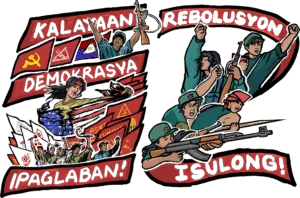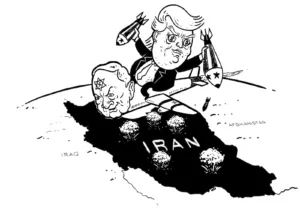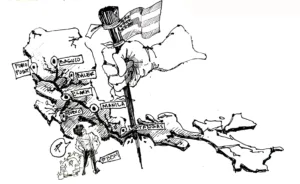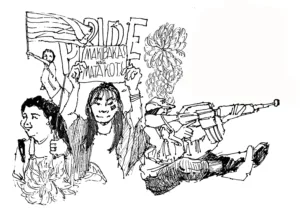
By Jose Maria Sison
Chief Political Consultant
National Democratic Front of the Philippines
Dear fellow peace advocates,
Warmest greetings of solidarity and peace!
Let me discuss the achievements of the peace negotiations between the Government of the Republic of the Philippines (GRP) and the National Democratic Front of the Philippines (NDFP) as well as the adversities and obstacles since 1992. Consequently, I share with you my perspective on these negotiations.
Achievements in the Peace Process
The achievements in the GRP-NDFP peace negotiations consist of a series of joint agreements that the GRP and the NDFP as negotiating parties have negotiated and mutually approved since 1992. Let me mention the most important ones. The limited time does not allow me to mention all agreements and all the goodwill and confidence-building measures like the ceasefire agreements of short duration and the releases of political prisoners and prisoners of war.
1. The Hague Joint Declaration was signed by the representatives of the GRP and NDFP on September 1, 1992. It sets forth the framework of the peace negotiations. This includes the aim of resolving the armed conflict through formal peace talks, the guiding principles of national sovereignty, democracy and social justice as well as the principle of non-capitulation by any of the negotiating parties, the method of negotiating and drafting the comprehensive agreements through reciprocal working committees and the substantive agenda for forging the comprehensive agreements on a. respect for human rights and international humanitarian law, b. social and economic reforms, c. political and constitutional reforms and d. the end of hostilities and disposition of forces.
It is clear that the attainment of a just and lasting peace is by addressing the roots of the armed conflict through social, economic and political reforms.
2. The Breukelen Joint Statement was signed and approved on June 14, 1994. This is the product of the first exploratory meeting of the GRP and NDFP negotiating panels after their delayed formation and after the failure of the intervening National Unification Commission (NUC) to carry out so-called localized peace negotiations under the direction and control of the GRP and its military. The NUC was unilaterally created by the GRP on September 2, 1992. The NDFP objected to the NUC as running counter to The Hague Joint Declaration and criticized it as a scheme to sabotage the peace negotiations and to misrepresent military assets as surrendering NPA fighters and as a futile psywar attempt to divide and disintegrate the revolutionary movement.
3. The Joint Agreement on Safety and Immunity Guarantees was signed and approved on February 24, 1995. It guarantees the safety and immunity of the negotiating panelists, consultants, advisers and resource persons, staff and other negotiating personnel of the GRP and the NDFP during and after the peace negotiations, irrespective of their results. It stipulates the holding of peace negotiations in a foreign neutral venue.
It firms up the consistent position of the NDFP that the formal peace talks be held abroad in order to avert the consequences of GRP military surveillance which were adverse to the NDFP negotiating personnel and staff during and after the ceasefire talks and the ceasefire agreement froms 1986 to 1987 during the Aquino regime. Abductions and murders of NDFP negotiating personnel were done after the ceasefire agreement broke down as a result of the Mendiola massacre of peasants and their urban supporters on January 23, 1987.
4, The Joint Agreement on the Formation, Sequence and Operationalization of the Reciprocal Working Committees (RWCs) was signed and approved in the course of the formal opening of the GRP-NDFP peace negotiations in Brussels on June 25, 1996. It guides how the comprehensive agreements are to be drafted by the reciprocal working committees for negotiations by the negotiating panels in accordance with the substantive agenda.
5. Additional Implementing Rules Pertaining to the Documents of Identification was signed on June 26, 1996. It reinforces the Joint Agreement on Safety and Immunity Guarantees. It stipulates the exchange of lists and number of persons to be mutually agreed upon for coverage by the safety and immunity guarantees.
6. The Comprehensive Agreement on Respect for Human Rights and International Humanitarian Law (CARHRIHL) between the GRP and the NDFP was signed by the GRP and NDFP negotiating panels in The Hague on March 16, 1998. This is the most important agreement so far made by the GRP-NDFP negotiating panels and mutually approved by their respective principals. It is the accomplishment of the first item of the four items in the substantive agenda of the peace negotiations. It was the product of a total of six months of continuous negotiations and drafting by the reciprocal working committees and the GRP and NDFP negotiating panels.
7. The Joint Agreement in Support of Socioeconomic Projects of Private Development Organizations and Institutes was signed on March 16, 1998. It is an agreement that allows and encourages socioeconomic initiatives by nongovernmental entities. It is valid and effective even before the Comprehensive Agreement on Social and Economic Reforms is negotiated and mutually approved.
8. The Joint Statement of the GRP and NDFP Negotiating Panels on March 9, 2001. It has the signal importance of demonstrating how the peace negotiations can be resumed after a unilateral act of termination by a negotiating party. It reaffirmed The Hague Joint Declaration of 1992 and all other subsequent agreements of the two parties in order to override the act of termination made by the Estrada regime.
It was during the time of the Arroyo regime that the GRP and the NDFP agreed to have the Royal Norwegian Government as the third party facilitator responsible for providing the foreign neutral venue for the peace negotiations and the resources for the purpose. The GRP and the NDFP also agreed on the Operating Guidelines of the Joint Monitoring Committee under CARHRIHL. This mechanism is important for the recording and exchange of complaints under CARHRIHL in order to deal with said complaints and ensure the continuity of the peace negotiations. Through a GRP-NDFP joint statement, the GRP assured the NDFP that the victims of human rights violations under the Marcos fascist regime would receive indemnification from the Marcos loot recovered from Switzerland.
During the first year of the Duterte regime, the prospects for accelerated peace negotiations and agreements were bright even as the new president reneged on his promise on May 16, 2016 to amnesty and release all political prisoners before the resumption of peace negotiations. The longest ceasefire between the armed forces of the GRP and the NDFP occurred from August 2016 to February 2017. There was an agreement to accelerate the negotiations of all three remaining items of the substantive agenda, without violating the intact agreement on the sequence of comprehensive agreements.
The GRP and NDFP reciprocal working committees have initialed the Guiding Principles and Sections on Agrarian Reform and Rural Development and National Industrialization and Economic Development of the Comprehensive Agreement on Social and Economic Reforms (CASER). Tentative agreements were made for a joint ceasefire in conjunction with the approval and implementation of the CASER.
The aforementioned agreements can be regarded as positive factors for resuming the peace negotiations at any time. They can be the base for forging the three remaining comprehensive agreements and for completing the peace process.
Since 2017 the NDFP has drafted its own full version of the CASER and has published this in 2018. For its own internal study and in readiness for the resumption of peace negotiations in the future, the NDFP also has tentative drafts of the Comprehensive Agreement on Political and Constitutional Reforms and the Comprehensive Agreement on the End of Hostilities and Disposition of Forces.
Adversities and Obstacles to the Peace Process
It is a fact that the GRP and NDFP are two contending parties or belligerent forces in a civil war but have agreed to become negotiating parties open to addressing and resolving the root causes of the armed conflict. Accordingly, the NDFP has always made clear that it is open to comprehensive agreements on bourgeois democratic reforms under the guiding principles of national sovereignty, democracy and social justice. It has never prematurely made socialist or communist demands in the peace negotiations.
But the GRP has had difficulties deciding and acting independently of the traditional dictates of foreign monopoly capitalism, domestic feudalism, bureaucratic corruption and repression. Whenever peace negotiations were delayed, disrupted or terminated, certain reactionary motivations of the GRP became conspicuous, such as seeking the capitulation and destruction of the revolutionary movement of the NDFP and abandoning the substantive agenda for addressing the roots of the armed conflict to benefit the people and build a just and lasting peace.
Take note of the fact that every GRP regime has carried out strategic military plans to destroy the revolutionary movement while the peace process or even a ceasefire is going on. The Duterte regime has been the most violent and vociferous in seeking to destroy the revolutionary movement by purely military means under the slogan of rabid anti-communism. This is in contempt of the broad masses of the people who are conscious of imperialism, feudalism and bureaucrat capitalism as the biggest problems plaguing them.
Duterte and his military minions try to discredit the GRP-NDFP peace negotiations by claiming that these have achieved nothing in 25 years from 1992 to 2017. In fact, these have achieved a lot despite delays, disruptions and terminations, which have cut down the days of productive bilateral formal peace talks to less than a year despite the passage of more than 25 years since 1992. Far more time has been devoted to expensive but futile strategic operational plans of the military and to the sabotage of the peace negotiations.
Despite the fact that most of the aforesaid major agreements were negotiated and mutually approved during the Ramos administration, the peace process was disrupted almost immediately after the signing of the The Hague Joint Declaration, with Ramos creating the National Unification Commission (NUC) on September 2, 1992 to undertake the “localized peace talks”. The NDFP promptly denounced this as an attempt to divide and destroy the revolutionary movement and to scuttle the peace process. The NUC prevented the start of the formal peace talks until 1994 when it was clearly proven that the NUC could not realize the so-called localized peace talks.
Right after the formal opening of the peace negotiations in Brussels in 1995, Defense Secretary Renato de Villa insisted on detaining Sotero Llamas and disrespecting the agreement to release him as a consultant in the peace negotiations. However, as soon as Llamas was released, the peace talks proceeded and progressed relatively fast. Several major agreements were forged in quick succession.
The GRP-NDFP Negotiating Panels and their respective reciprocal working committees had the distinction of negotiating, finalizing and signing the Comprehensive Agreement on Respect for Human Rights and International Humanitarian Law within only six months in 1997 to 1998. But GRP President Ramos hedged from signing the agreement until his term ended in 1998,
President Estrada signed the CARHRIHL on August 7, 1998 but terminated the peace negotiations on May 29, 1999 as a reaction to the capture of General Obillo and Captain Montealto by the New People’s Army under conditions of no ceasefire agreement and despite the willingness of the NDFP to release the prisoners of war. He also took offense from the patriotic opposition of the NDFP to the US-RP Visiting Forces Agreement. No peace negotiations occurred for most of the years that Estrada was in power.
President Arroyo and the GRP Negotiating Panel agreed to resume the peace negotiations and reaffirm all previous agreements in early 2001. She also agreed to the Royal Norwegian Government becoming the third party facilitator and to the Joint Agreement on the Operating Guidelines for the Joint Monitoring Committee which had been created under a provision of CARHRIHL.
But in April 2001, under increasing militarist influence of her national security advisers, Arroyo found cause to “suspend” the peace negotiations indefinitely over the death of Cagayan governor Rodolfo Aguinaldo who had resisted arrest by the New People’s Army on the basis of an arrest order long issued by the People’s Court for grave crimes of human rights violations during and after the Marcos fascist regime. For nine long years, during the time of the Arroyo regime, there were no peace negotiations.
The Aquino administration agreed to resume the peace negotiations and reaffirm all previous agreements. But the National Security Cluster of the Cabinet and the Office of the Presidential Adviser on the Peace Process (OPAPP) repeatedly disrupted the peace negotiations by seeking to subordinate these immediately to the sole authority of the GRP and demanding an indefinitely prolonged ceasefire before the negotiations on the Comprehensive Agreement on Social and Economic Reforms (CASER).
The OPAPP secretary also directed the Chairman of the GRP Negotiating Panel to pontificate that the The Hague Joint Declaration was a document of perpetual division and the CARHRIHL was a propaganda document of the NDFP and to insult the NDFP as aiming for the moon by demanding social, economic and political reforms. Consequently, the peace negotiations broke down without making any significant progress. There was practically no advance whatsoever in taking up social and economic reforms during most of the six years of Aquino in power.
Before Duterte became president, he was harping on the line that he would immediately negotiate peace with the NDFP and form a coalition government with the CPP. On May 16, 2016, he promised to amnesty and release all political prisoners upon assumption of office. He did not fulfill this promise and thus caused the NDFP to doubt his further pronouncements.
Despite the ceasefire agreement from August 2016 to the first week of February 2017, the Duterte regime continued with its all-out war policy and operations against the revolutionary movement by continuing Aquino’s Oplan Bayanihan until he launched his own Oplan Kapayapaan in January 2017. Then he issued the proclamation of martial law in Mindanao on May 23, 2017, which openly made the revolutionary movement a target of all-out war.
Soon enough, Duterte issued Proclamation 360 to terminate the GRP-NDFP peace negotiations and Proclamation 374 to designate the Communist Party of the Philippines and the New People’s Army as “terrorist” organizations. Further, he issued Executive Order No. 70 to create a national task force to end the revolutionary movement through a “whole nation” approach of militarizing the government and society along the line of rabid anticommunism. The repressive policies and actions continue to escalate.
Even as the Duterte regime has terminated the GRP-NDFP peace negotiations, the OPAPP now under the complete control of the rabidly anti-communist military has sought to repeat the psywar scheme of the National Unification Commission in 1992 to 1994 to stage “localized peace talks” under the direction and control of the GRP military. Like the NDFP, the NPA at every level of command has publicly condemned the so-called localized peace talks. As in 1992 to 1994, the reactionary military and police forces have merely staged fake surrenders aside from concocting fake encounters and inflicting a wide range of human rights violations on the people.
The real purpose of the Duterte regime in ending the peace negotiations is to blame the revolutionary movement for the armed conflict and to realize Duterte’s scheme of fascist dictatorship. In the process, the regime has undertaken a series of measures by which the president as commander-in-chief has used the military and polices forces to violate the civil and political rights of all deemed opposed to the regime.
The regime tries in vain to terrorize the people with the use of red-tagging, trumped up charges, planting of evidence, abductions, torture, assassinations, mass murders, bombings and forced mass eviction of urban poor dwellers, peasants and indigenous people in order to generate a climate of fear and facilitate the repression of all those opposed to the regime, including the legal opposition, critics, social activists and ordinary people.
Perspective on Resuming the Peace Process
By knowing both the achievements of, as well as the adversities and obstacles, to the GRP-NDFP peace negotiations, we know what positive factors to develop and what negative factors to overcome.
The positive factors are the agreements, the experience and expertise that have arisen and accumulated over time. The support of the peace advocates and the broad masses of the people is certainly positive factor in favor of the peace negotiations. The negative factors involve mainly the rabid anticommunism and the presumption that the GRP can deliver services to the people and end the armed revolutionary movement through sheer military force and not through peace negotiations.
It is during the current Duterte regime that the negative factors are so overwhelming on the side of the GRP, as manifested by the series of presidential issuances to terminate the peace negotiations, designate the CPP and NPA as “terrorists” and create a national task force for the militarization and fascisation of government and society under the banner of anticommunism.
While Duterte and his ruling clique remain in power, there is no hope for the resumption of the GRP-NDFP peace negotiations due to their obsession to escalate repressive measures and impose a fascist dictatorship on the Filipino people under the pretext of fighting and defeating “communism” and the armed revolution.
There is only a small chance that Duterte will be willing to resume peace negotiations if he is convinced of the futility of his enterprise to destroy the revolutionary movement by sheer armed force and if he is moved to recognize and respect the tremendous growth of the broad popular opposition as well as that of the armed revolutionary movement, resulting precisely from the current escalation of oppression and exploitation.
But the revolutionary movement most probably will not find it useful to engage in peace negotiations with the GRP under the Duterte regime when this is already on the verge of being ousted or is approaching the end of its term. If the ouster movement becomes imminent, the revolutionary movement would find it more reasonable, beneficial and necessary to help accelerate the regime’s downfall and negotiate with the next GRP administration.
It is advisable for all those honestly interested in peace negotiations, aside from the GRP and the NDFP, to continue working for the resumption of peace negotiations as soon as conditions permit. We look forward to the struggle of the Filipino people against tyranny, treason, plunder and deception generating better conditions for peace negotiations.
The antinational and antidemocratic character of the Duterte regime has aroused a broad range of patriotic and progressive forces and the broad masses of the people to demand the resumption of peace negotiations as the way for advancing and realizing full national independence, democracy, social justice, economic development, cultural progress and international solidarity.











